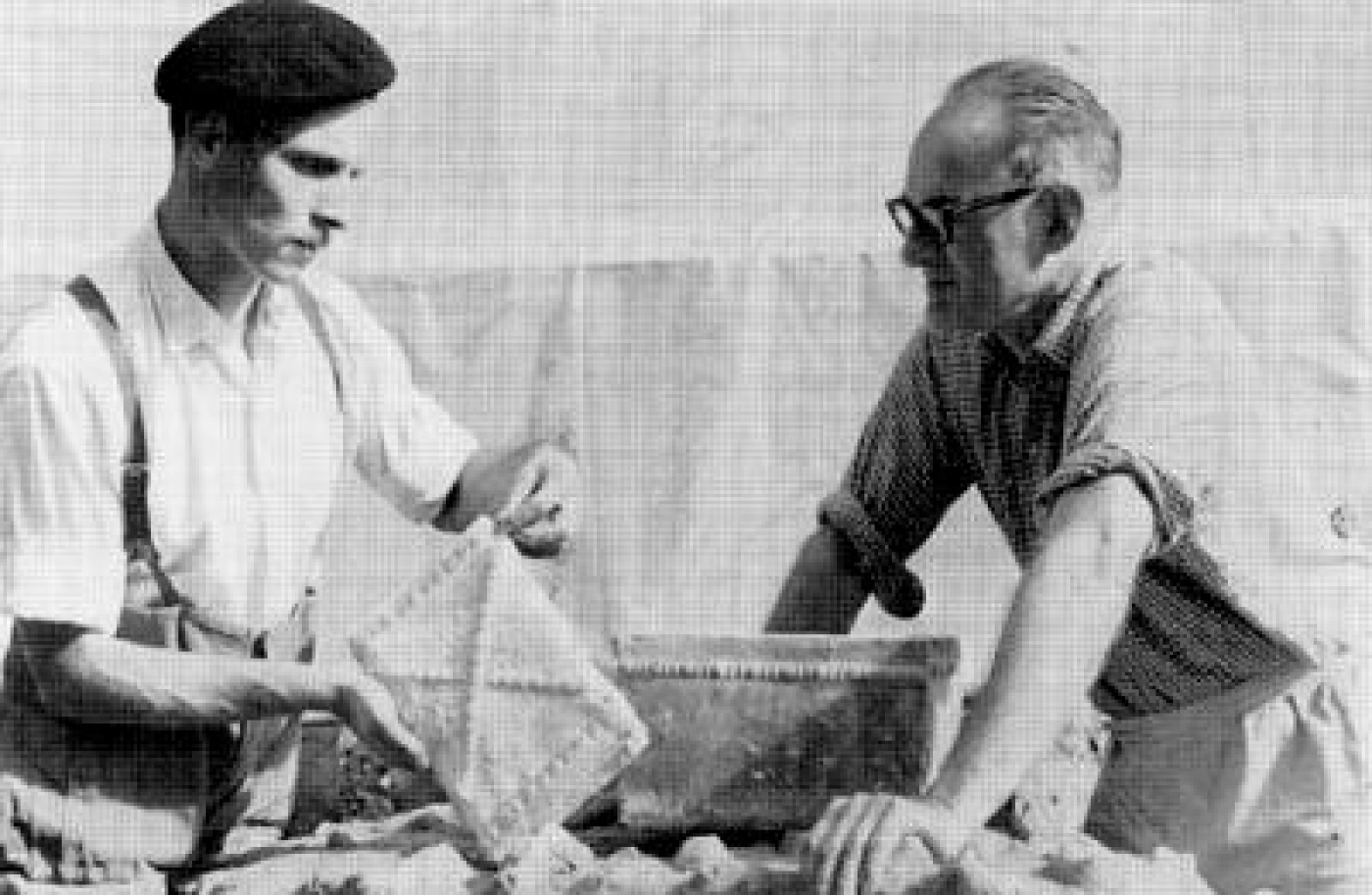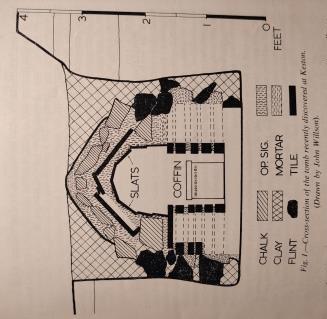The Excavation of the Roman Cemetery at Keston
The excavations at Warbank, Keston reached a dramatic climax early in the autumn when a previously unknown Roman tomb was discovered. This had been missed by three earlier excavations carried out on the site over a period of about 130 years.
The West Kent Border Archaeological Group started work on the site in May. 1967 (details in K.A.R. No. 9 page 8). The primary aim was to totally excavate two substantial masonry tombs, or mausolea, plundered sometime in the 18th century and which were suffering badly from the effects of weathering. The Bromley Council had invited the Group to carry out the work and also agreed to finance a programme of consolidation.
The principal tomb, a huge circular structure at least 30 ft. in diameter (Plate 1), had been supported by six large external buttresses. It was between two of these buttresses, on the west side of the structure, that the new tomb was found. The area
had in fact been excavated in 1828, but the tomb was then missed owing to its depth. Indeed it was only by a critical examination of what appeared to be natural soil that the top of the vault of the tomb was detected!
The subsequent excavation of the tomb by the Group revealed the sequence of its construction (see Fig. 1). Initially a rectangular pit, about 5 by 3 ft. in area and some 3ft. deep, had been dug just outside the wall of the circular mausoleum. In this pit a compact chamber, or cist, had been built of tiles set in white mortar. This enclosed a small cavity some 15 by 10 inches across. At the ends of the cist (not shown in the cross-section) were two large semi-circular chalk blocks. These supported eight wooden slats which together formed a vault over the chamber. On this shuttering was poured liquid pink-cement (opus signinum) which was then allowed to set. A bridge of roof-tiles (tegulae) was then formed across the tomb and this was covered by chalk blocks set in more pink-cement. The whole structure was covered over with clay and chalk, probably the same soil that had been dug from the original pit.
When the tomb was eventually opened it was found to contain a small lead casket, or coffin, in a very fine state of preservation. This was rectangular in shape and closed by a well-fitting lid, also made of lead. Both the coffin and the lid were decorated with beading of the so-called bead-and-reel type (astragal beading) as commonly found on Roman coffins of this type. Inside were cremated bones on which faint traces of woven material representing a container in which the bones may have been placed. The bones are now being studied.
 |
 |
| Plate 1. The circular mausoleum. (Photo by Alan Jones). | Plate 2. Gerald Clewley and Dick Broadfoot Examine the lead coffin after its removal from the tomb. (Photo by David Witherspoon) |
Professor J. M. C. Toynbee, in her study of Kentish lead coffins of Roman date (Arch. Cant. 1954, page 40), lists 22 all of which are larger than that from Keston. Many of those listed have since been lost. One was stolen from the British Museum in 1950, another was melted down to seal the joints in the gas-mains at Sittingbourne and another was sold to a dealer for scrap. A fine example, excavated by Ronald Jessup at Holborough, Snodland, is now on display in Maidstone Museum.

As the excavation at Keston progressed, a narrow chalk and flint wall was found to enclose the new tomb, forming an apse springing from the two adjacent buttresses. Thus the tomb was enclosed by masonry on all four sides. Clearly this new tomb was added sometime after the completion of the principal mausoleum and in this respect it can be regarded as a secondary burial.
Mr. Jessup, as the leading authority on Roman barrows and tombs, was invited to the site having been associated with it for many years. In 1958 he published his paper, 'Barrows and Walled Cemeteries in Roman Britain' (Journal of the Arch. Assoc. XXII p.24), in which he suggested that the Warbank tommed part of a walled cemetery such as occur at several other sites in Kent. In particular the site at Joy Wood Lockham offers a useful parallel, for there a circular and a rectangular tomb were found within a walled area (Arch. Can. XV (1883), p. 76). Mr. Jessup has suggested that the circular tomb at Keston probably rose to a height of at least 20 ft. and that it was earth-filled. In effect the tomb was an earthern barrow contained within a delimiting wall which may have incorporated archi- tectural refinements. The largest tomb of this type seems to have been the mauso- leum of Augustus at Rome which had an overall diameter of about 205 ft. Other circular tombs of large size occur in Britain at Mersea, Essex (Victoria County History, Essex. Vol. III. p. 159) and at Pulborough. Sussex (Sussex Arch. Coll. Vol. XI. p. 141).
If the newly discovered tomb at Keston can be considered as a secondary burial relating to the principal tomb, then the barrow at Snodland offers an interest- ing parallel. There the primary burial was an adult cremation buried in a wooden coffin datiing from the early third century. A secondary burial had later been dug into the south-east side of the barrow and this contained the skeleton of a child in a small lead coffin. The Keston mausoleum, like the Snodland barrow, must have contained an important primary burial which it seems was made c. A.D. 200. The new tomb situated on the west side of the main structure represents, in effect, a secondary burial as at Snodland and it too contained a small lead coffin though here the bones had been cremated.
The work at Keston is to continue and the prospects, despite the earlier excavations, are good. On the east side of the circular mausoleum another apsidal wall of chalk and flint was reported in 1893. The discovery was later repudiated and it has since been struck from the records. The recent discovery, however, of an identical wall on the west side may suggest that yet another tomb still awaits discovery.
During the latter part of the excavation special permission was obtained from the site-owners for the site to be opened to the general public. During two weekends more than 1100 people made the difficult journey to the site where guides showed finds and explained the various tombs. A small pamphlet about the work and the site generally was specially printed and large numbers were sold.
The consolidation work and site-levelling will continue for some of the winter months, but the excavation is not yet open to the public. The Group gratefully acknowledges the interest and encouragement of the late Mr. Alec Brooksbank of the Keston Foreign Bird Farm.
BRIAN PHILP.
Further Work at Warbank, Keston
